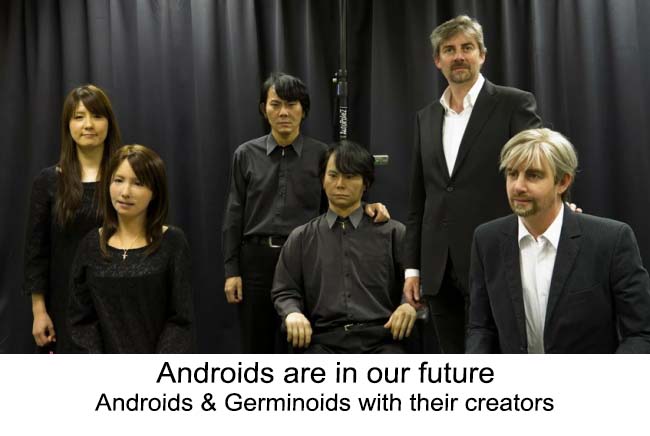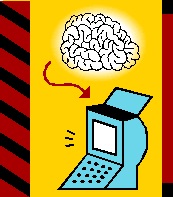 The Internet and the World Wide Web are confirming examples that homo sapiens, as a tool-making species, is slowly but inexorably in the process of replicating themselves—that is, externalizing their senses to the point–perhaps some two hundred years down the road–where the highly sophisticated Star Trek, The Next Generation character D.A.T.A. may actually become a reality.
The Internet and the World Wide Web are confirming examples that homo sapiens, as a tool-making species, is slowly but inexorably in the process of replicating themselves—that is, externalizing their senses to the point–perhaps some two hundred years down the road–where the highly sophisticated Star Trek, The Next Generation character D.A.T.A. may actually become a reality.
Moreover, every step man takes technologically he further extends his senses—into the microcosmic, across the planet, into space. In effect, over the eons we have taken quantum leaps from the non-literate old man sitting around the campfire telling the stories of the tribe face-to-face with the members of the tribe, to the current manifestation of technology where the tribe is global (Marshal McLuhan’s so-called “global village”) and the community of man is global.
Yet, we are going in two directions simultaneously. In the face of global communications, time and time again marketing, advertising and organizational communications subject experts I have interviewed talk about one-on-one marketing, one-on-one customer contact, a one-on-one relationship with an individual anywhere on the planet with access to a computer, a modem, and an Internet hookup. This expression of the Internet experience reflects the steps in technology we have taken which bring us that much closer to the full externalization of human characteristics and behavior. Everything about the Internet and the World Wide Web is taking us further in the direction of a replication of the human, face-to-face experience.
Our current electronic/photonic technologies began with the development of the first speed of light technology—the telegraph—in 1838. Since then we have been moving towards the  externalization of our senses on a global scale. The Internet and the World Wide Web are a confluence of previous electronic technologies: the telephone, television, telecommunications, video, audio, radio, text, computer graphics, film, computers, and micro-processors. But the Internet and the World Wide Web are not de-humanizing media. On the contrary, they enhance humanity’s ability to communicate. We are in the process of creating new communities around the world on a macrocosmic scale and on a microcosmic scale in regional and local communities.
externalization of our senses on a global scale. The Internet and the World Wide Web are a confluence of previous electronic technologies: the telephone, television, telecommunications, video, audio, radio, text, computer graphics, film, computers, and micro-processors. But the Internet and the World Wide Web are not de-humanizing media. On the contrary, they enhance humanity’s ability to communicate. We are in the process of creating new communities around the world on a macrocosmic scale and on a microcosmic scale in regional and local communities.
Internet developments support the view that this technology is pushing the “humanization” of media. In other words, the Internet will increasingly act like a person. For example, the Internet will take on more of a “voice,” such as “You’ve got mail.” A study several years ago by Killen & Associates, Internet Voice: Opportunities and Threats forecast that global voice/Internet services revenues will top $63 billion by the year 2002 from $741 million in 1997. Further, approximately 48% of the 2002 revenues will be generated in North America while 33% will come from Europe. The bad news for carriers is that the revenues generated by voice/Internet traffic will mostly supplant old telephone service revenues, according to the study. Today, increasing numbers of households have given up the old landline technology in favor of the moble phone.
From the user’s perspective, the Net will become more alive, more interactive, more conversational, more personal, more individualized, more human-like.
Many technological antecedents to the humanization continuum are already in place: robotics, miniaturization, mechanical hearts, man-made materials to replace bones and skin, limb prosthetics, faster, smaller, smarter computers.
Take a look at your computer. If you have stereo speakers, imagine the speakers as ears, the computer monitor a face, the keyboard a mouth, the CPU a brain (although in this case it is separate from the face). Imagine, then, that this crude head is mounted on top of a highly sophisticated robotic device with the ability to move.
 Technological mobility is an eventuality. Two central factors pervade the adoption of a new technology: standardization and mobility. Examples abound. When the Greeks standardized the alphabet it also became de facto mobile. Same is true of printing, photography, radio, television, video, telecommunications. All these technologies are mobile. And now—with laptops and smartphones of all types—so are computers. A laptop is just several steps away from evolving into a mobile, robotic brain.
Technological mobility is an eventuality. Two central factors pervade the adoption of a new technology: standardization and mobility. Examples abound. When the Greeks standardized the alphabet it also became de facto mobile. Same is true of printing, photography, radio, television, video, telecommunications. All these technologies are mobile. And now—with laptops and smartphones of all types—so are computers. A laptop is just several steps away from evolving into a mobile, robotic brain.
In 1997 researchers at the Department of Energy’s Oak Ridge National Laboratory (ORNL), in Oak Ridge, Tennessee developed a half living, half silicon chip dubbed “Critters on a Chip.” This integrated circuit consists of living sensors—such as bioluminescent bacteria placed on a standard integrated circuit, or chip. Officials at ORNL have boasted that the chip is small, inexpensive and provides information quickly: “This new development using an integrated chip‑based approach with living organisms could dramatically advance the ability to sense a variety of chemical agents in the environment, such as chemical warfare agents or other toxic substances and things like environmental estrogens that could have detrimental effects on living systems. . . .If it is indeed possible to manufacture these part-electronic and part-biological systems as a small, inexpensive chip, it would dramatically improve the ability to monitor many different types of environments.” (from Michael McPherson, Editor & Publisher, SCCM e‑zine, Social & Charitable Cause Marketing, sccm@netrax.net, PRFORUM LISTSERV, April 18, 1997).
It is possible. Materials scientist John Rogers and his team at the University of Illinois at Urbana-Champaign have developed materials for use inside the human body that are called “tran-science.” This is technology that is born to die, such as sensors that track blood pressure in the aorta after heart surgery, then dissolve once a patient is out of the woods. They have also made eyeball-shaped cameras that mimic human and insect sight, and soft threads of tiny LEDs that can be injected right into the brain. (See Smithsonian Magazine, December 2013).
In parallel to these technological developments, the Internet and other electronic media are actually fostering more human, face-to-face contact. These media do not separate people.  They bring them together. If this were not so, why then has travel around the world expanded? It is not just growth in business travel, it is also people visiting other people on a global scale. I concur with John Naisbitt’s “High tech, high touch” postulate—that as we increase our level of high technology, there is a similar response in the human realm; that as we use more high technology to communicate, as human beings we develop an increased need to “press the flesh,” even if that flesh is at a distance.
They bring them together. If this were not so, why then has travel around the world expanded? It is not just growth in business travel, it is also people visiting other people on a global scale. I concur with John Naisbitt’s “High tech, high touch” postulate—that as we increase our level of high technology, there is a similar response in the human realm; that as we use more high technology to communicate, as human beings we develop an increased need to “press the flesh,” even if that flesh is at a distance.
In Global Paradox (Avon Books, New York, 1994) Naisbitt made the case that travel is one of the world’s biggest industries, not energy, manufacturing, electronics, or agriculture. As of a couple of years ago, tourism and travel employed 98 million+ people.
As we continue to expand our ability to reach individuals and mass audiences at great distances, we are also becoming more consumed with local and regional issues, sometimes to the detriment of national and global concerns. Simultaneously, there has been an explosion of human interaction on a global scale, as the trends in travel indicate. There are also more arts and sports events. And observe the greater interest in special events, conferences, and conventions. While some social critics might observe that gathering at a sports event is not socializing, it does indicate man’s drive to commune in some form.
This gathering of tribes on a global scale has caused other ramifications as well as clashes. First, English has become the de facto  language of business in the world. In the last several dacades alone, approximately half of the world’s languages have simply vanished. Meanwhile, English becomes more and more the global language of commerce, not just because the United States remains one of the world’s economic superpowers, but because, as the most hybrid of all major languages, English has the greatest capacity to absorb and fuse the useful remnants of dying tongues. Thus, if you’re going into any kind of business, your strategic use of the English language—both written and oral—needs to be very strong.
language of business in the world. In the last several dacades alone, approximately half of the world’s languages have simply vanished. Meanwhile, English becomes more and more the global language of commerce, not just because the United States remains one of the world’s economic superpowers, but because, as the most hybrid of all major languages, English has the greatest capacity to absorb and fuse the useful remnants of dying tongues. Thus, if you’re going into any kind of business, your strategic use of the English language—both written and oral—needs to be very strong.
 Second, very generally speaking, according to Edward T. Hall, author of Beyond Culture (New York: Anchor Publishing, 1976) there are two kinds of cultures in the world with variations in between: low context and high context. High context cultures are more sensitive to the surrounding circumstances or context of an event. This is apparent in communication in which non-verbal cues play a significant role in the interaction. Although no culture exists exclusively at either end of the context scale, some cultures, such as the Asian, Hispanic, and African-American are high-context; others, such as Northern European and American, are low-context. When east meets west, the communication can be a challenge, whether on foreign or domestic soil.
Second, very generally speaking, according to Edward T. Hall, author of Beyond Culture (New York: Anchor Publishing, 1976) there are two kinds of cultures in the world with variations in between: low context and high context. High context cultures are more sensitive to the surrounding circumstances or context of an event. This is apparent in communication in which non-verbal cues play a significant role in the interaction. Although no culture exists exclusively at either end of the context scale, some cultures, such as the Asian, Hispanic, and African-American are high-context; others, such as Northern European and American, are low-context. When east meets west, the communication can be a challenge, whether on foreign or domestic soil.
For professionals in all fields the evolving media environment requires both media studies and human studies. It is qualitative and quantitative. It requires strong written and oral communications skills. It requires technological skills and people skills. It requires a broad view of the world, but with an eye on the details in one’s own backyard.
Please write to me at meiienterprises@aol.com if you have any comments on this or any other of my blogs.
Eugene Marlow, Ph.D.
August 11, 2014
© Eugene Marlow 2014

